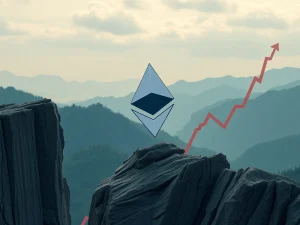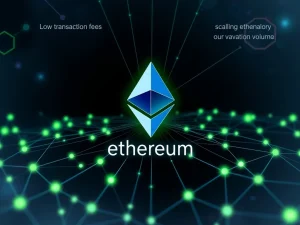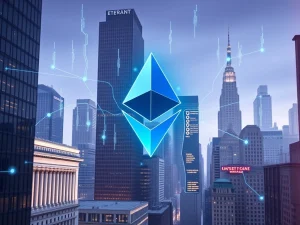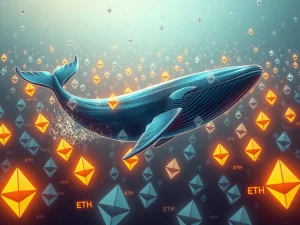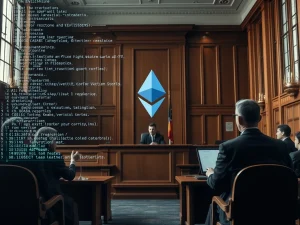Ethereum Upgrades: Vitalik Buterin’s Transformative Vision for Scaling

Hey crypto enthusiasts! Ever wonder what keeps Ethereum at the forefront of blockchain innovation? It’s not magic; it’s a relentless cycle of evolution. Today, we’re diving deep into the mind of Ethereum’s co-founder, Vitalik Buterin, and his ambitious vision for the network’s future, focusing on crucial Ethereum upgrades like Pectra and Glamsterdam.
Why Do Ethereum Upgrades Matter So Much?
Ethereum isn’t just a cryptocurrency; it’s the backbone for decentralized finance (DeFi), NFTs, and Web3. But staying the heavyweight champion requires constant adaptation. The network faces significant challenges:
- Scalability: Handling millions of transactions quickly.
- Gas Fees: Making transactions affordable for everyone.
- User Experience: Simplifying interactions for mainstream users.
- Centralization Risks: Ensuring the network remains decentralized as it grows.
Competitors are fast, offering high transaction speeds and slick interfaces. For Ethereum to hold its ground, its core technology must keep improving. Every upgrade is a strategic step to tackle these issues head-on, ensuring Ethereum can scale without sacrificing its core principles.
Vitalik Buterin‘s Renewed Focus: Charting Ethereum’s Deep Future
In 2024, a significant shift occurred at the Ethereum Foundation. Vitalik Buterin stepped back from daily operations to dedicate himself entirely to long-term research. This move frees him to explore the most complex challenges facing Ethereum.
His primary research areas now include:
- Advanced Scaling: Exploring novel execution models beyond current rollups to make Ethereum faster and cheaper.
- Native Privacy: Developing built-in features like stealth addresses to protect user privacy by default.
- Protocol Redesign: Rethinking how nodes validate and process data for a more scalable and decentralized future.
Vitalik envisions an ecosystem that is not only massively scalable but also inherently open, trustless, and adaptable to a complex global landscape.
From Merge to Splurge: Ethereum’s Conceptual Roadmap
Ethereum’s evolution is often described in six conceptual phases, each addressing a fundamental challenge:
- The Merge: Transitioned from energy-intensive Proof-of-Work (PoW) to efficient Proof-of-Stake (PoS).
- The Surge: Focuses on Ethereum scaling via rollups and data availability (like EIP-4844), targeting higher transaction throughput.
- The Scourge: Aims to mitigate MEV (Maximal Extractable Value) and enhance staking decentralization.
- The Verge: Introduces Verkle Trees and SNARKs for more efficient state access and stateless clients.
- The Purge: Simplifies the protocol by removing historical data and reducing node requirements.
- The Splurge: A catch-all for ongoing improvements, polishing, and miscellaneous features.
Get Ready for Pectra: The Next Major Ethereum Upgrade
The Pectra upgrade, anticipated around May 2025, is a crucial step. Its name comes from merging two development tracks: Prague (execution layer) and Electra (consensus layer). This single release bundles over a dozen EIPs (Ethereum Improvement Proposals) designed to set a robust foundation for the network’s next phase.
Key features expected in the Pectra upgrade include:
- EIP-2537 (BLS12-381 Precompiles): Essential for efficient zero-knowledge proofs, boosting rollup performance.
- EIP-7002 (Triggerable Exits): Allows validators to initiate exits via the execution layer, improving staking flexibility.
- EIP-7702 (Account Abstraction): Enables externally owned accounts (EOAs) to behave more like smart contracts, paving the way for gasless transactions and better wallet experiences.
- EIP-7840 (Blob Schedule): Prepares for increased data capacity needed for rollup scaling.
These changes contribute to features like the Ethereum Object Format (EOF) for modular contracts and bring native account abstraction closer, promising a smoother experience for users and developers alike.
What Comes After Pectra? Fusaka and The Glamsterdam Update
The roadmap doesn’t stop with Pectra. The next significant milestones are Fusaka and Glamsterdam, pushing the boundaries of Ethereum scaling and efficiency.
- Fusaka (Osaka-Fulu): This upgrade is set to introduce PeerDAS (Peer Data Availability Sampling). PeerDAS is a breakthrough that allows nodes to verify data availability by sampling small portions instead of downloading entire blocks. This drastically reduces the burden on nodes and enables a significant increase in data throughput, vital for layer-2 rollups.
- Glamsterdam (Amsterdam–G-Star): Still in earlier design stages, the Glamsterdam update will focus on further gas optimizations and protocol-level efficiency. It aims to make transactions cheaper and faster, especially for complex applications and layer-2 interactions.
While Fusaka directly boosts data capacity, Glamsterdam ensures the network runs smoothly and cost-effectively under heavy load. Together, they represent Ethereum’s move towards becoming a high-throughput global settlement layer.
Vitalik Buterin‘s Research Beyond the Immediate Roadmap
Beyond the planned upgrades, Vitalik Buterin‘s research explores more experimental territory, potentially shaping Ethereum for the next decade. His work includes:
- Post-EVM Architectures: Investigating alternatives or evolutions of the Ethereum Virtual Machine (EVM) for improved performance and modularity, possibly involving standards like RISC-V.
- Advanced Decentralized Scaling: Deepening the layer-2 focus with novel rollup designs and light client verification techniques.
- Balancing Innovation and Decentralization: Grappling with how Ethereum can continue to innovate while fiercely protecting its decentralized core in a complex regulatory and technological environment.
These research threads could lead to future upgrades that redefine the possibilities of a decentralized smart contract platform.
Ethereum Scaling While Protecting Decentralization: The Core Challenge
The central theme uniting all these efforts is the difficult balance between achieving massive Ethereum scaling and preserving the network’s decentralization. This is a challenge few other blockchains have managed successfully.
The upcoming consensus and execution upgrades are vital for several reasons:
- Mass Adoption: Lower fees and faster speeds are non-negotiable for bringing billions of users into DeFi, NFTs, gaming, and more.
- Layer-2 Ecosystem: A stronger layer 1 makes layer-2 rollups more secure and efficient, accelerating the growth of the entire Ethereum ecosystem.
- Long-Term Resilience: Fortifying the protocol now ensures Ethereum can withstand centralization pressures and remain censorship-resistant.
Vitalik’s vision, driving the Ethereum upgrades from Pectra to Glamsterdam and beyond, points to a future of radical flexibility, enhanced privacy, and unstoppable decentralization. As the Pectra upgrade date approaches and the Glamsterdam update takes shape, Ethereum’s commitment to innovation is clear. The journey to a massively scalable, modular, and decentralized network is in full swing.

